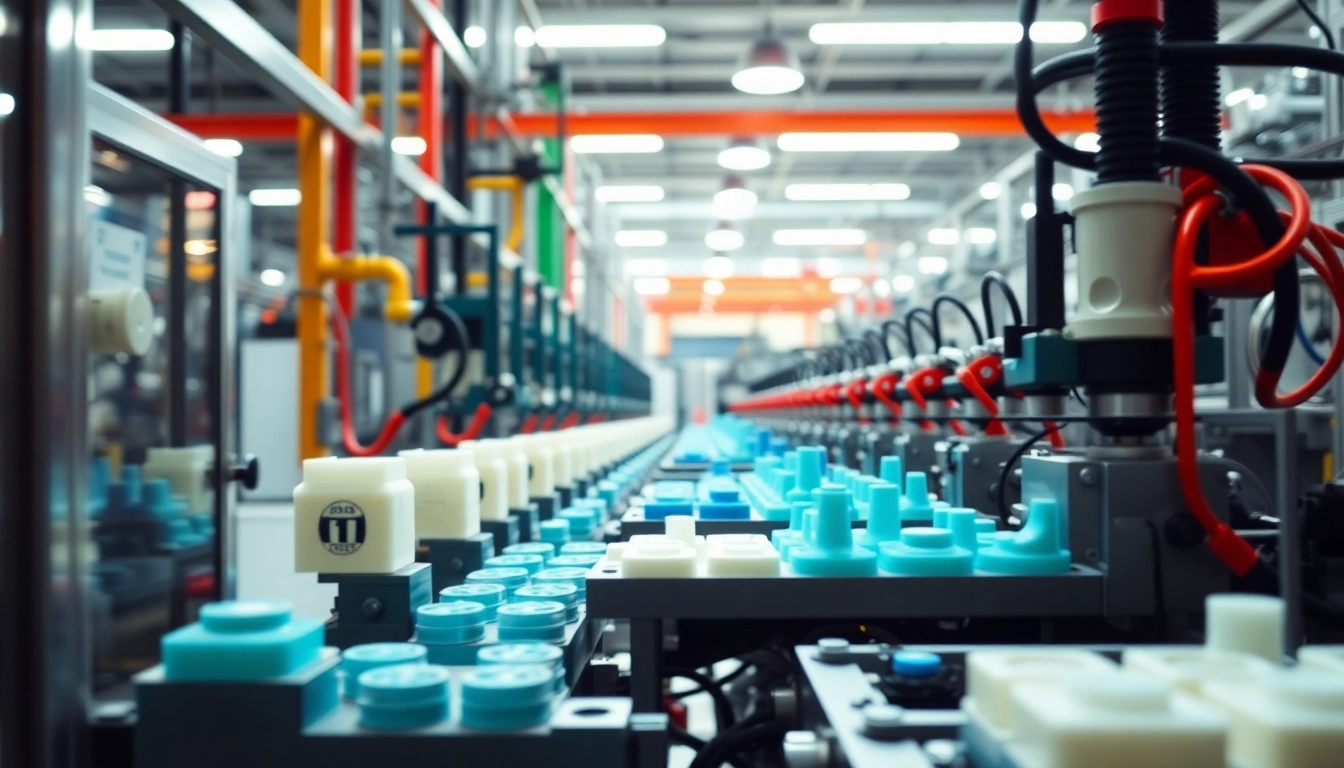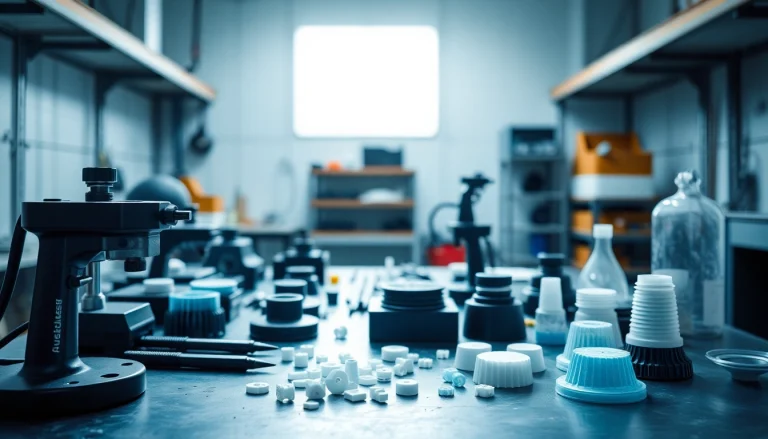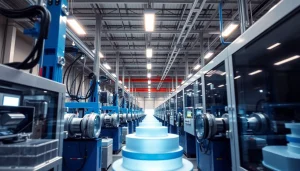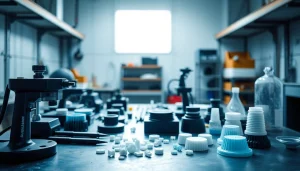Understanding Injection Molded Parts
What Are Injection Molded Parts?
Injection molded parts are manufactured using a process that involves injecting molten material into a mold. This method is primarily used for plastics, but it can also work with metals and ceramics. The process begins with the design of the mold, which dictates the shape and dimensions of the final product. Once the mold is ready, plastic pellets are heated until they melt and become pliable. The molten material is then injected at high pressure into the mold, where it cools and solidifies, taking the form of the mold cavity. This process results in high-precision parts that can be produced rapidly and consistently.
The rise of injection molded parts has revolutionized manufacturing, enabling industries to rapidly produce complex shapes and components that meet specific customer needs. This method is known for its efficiency and cost-effectiveness, particularly in mass production scenarios.
Benefits of Injection Molding
Injection molding offers numerous advantages, making it the preferred choice for many manufacturers:
- Efficiency: The process produces large quantities of parts quickly, reducing production time significantly.
- Cost-effectiveness: Once the mold is created, the cost per unit decreases with large production runs, making it economical for mass production.
- Precision: Injection molding allows for high precision in the dimensions and tolerances of parts, which is vital for industries such as aerospace and automotive.
- Material Variety: A wide array of materials can be used, from thermoplastics to elastomers, enabling manufacturers to choose the material best suited for their applications.
- Design Flexibility: Complex designs can be achieved that may be difficult or impossible with other manufacturing methods.
- Durability: The injection molding process produces strong, durable parts that can withstand mechanical stress.
Common Applications of Injection Molded Parts
Injection molded parts are ubiquitous in numerous industries, including:
- Automotive: Components such as dashboards, bumpers, and housing for electronic devices.
- Consumer Electronics: Enclosures for devices like smartphones and laptops.
- Medical Devices: Parts for syringes, blood filters, and other health equipment.
- Household Goods: Everyday items like plastic containers, toys, and kitchen tools.
- Construction: Items such as fittings and fixtures that require robustness and reliability.
Key Components of Injection Molding
Main Parts of an Injection Mold
The effectiveness of the injection molding process hinges on several key components of the mold itself. These parts include:
- Mold Base: The foundational component of the mold that supports the entire assembly.
- Cavity and Core: The two parts of the mold that create the final shape of the injection molded part.
- Ejector Pins: Used to eject the finished part from the mold once it has cooled and solidified.
- Sprue and Runner System: Channels that allow the molten material to flow from the nozzle into the mold cavity.
- Cooling Channels: Pathways within the mold that facilitate cooling, ensuring rapid solidification of the material.
Types of Injection Molding Machines
Injection molding machines can be categorized based on their operation methods, which affect the efficiency, speed, and flexibility of the manufacturing process:
- Hydraulic Machines: Commonly used for larger parts, utilizing hydraulic systems to generate force and operate the machine.
- Electric Machines: Known for their efficiency and precision, electric machines use servo motors to drive the injection process.
- Hybrid Machines: Combine elements of both hydraulic and electric systems to capitalize on their respective advantages.
Material Selection for Injection Molded Parts
Choosing the right material for injection molded parts is crucial, as it influences the performance, aesthetic, and durability of the final product. Commonly used materials include:
- Thermoplastics: Such as ABS, polycarbonate, and polyethylene, which are widely used due to their versatility and recyclability.
- Thermosets: Materials that, once set, cannot be remolded, offering better heat resistance.
- Elastomers: Flexible materials ideal for creating parts that require elastic properties.
Designing Injection Molded Parts Efficiently
Best Practices for Part Design
Efficient and effective design is pivotal in producing high-quality injection molded parts. Here are some best practices to consider:
- Maintain Uniform Wall Thickness: Standardizing wall thickness helps avoid warping and ensures consistent cooling.
- Incorporate Draft Angles: Adding draft angles allows for easier mold release and minimizes surface damage.
- Design with Tolerances in Mind: Understanding tolerances based on the material and production method improves fit and function.
Common Design Pitfalls to Avoid
Avoiding certain design pitfalls can lead to superior injection molded parts:
- Overcomplicating Design: Avoid excessive detail that may make the mold difficult or expensive to produce.
- Lack of Consideration for Shrinkage: Not accounting for material shrinkage can lead to size discrepancies in the finished product.
- Ignoring Ejector Pin Placement: Poor placement can lead to surface defects and complicate the ejection process.
Utilizing CAD Software for Design
Computer-Aided Design (CAD) software plays a fundamental role in modern product development. Benefits of using CAD in designing injection molded parts include:
- Improved Accuracy: CAD allows for precision in design measurements, reducing errors.
- Rapid Prototyping: Enables quick modifications and testing of designs before final production.
- Enhanced Collaboration: Facilitates sharing and combined working on designs amongst teams, streamlining the design process.
Production Process for Injection Molded Parts
Step-by-Step of the Injection Molding Process
The injection molding process is a structured and intricate sequence of steps:
- Mold Preparation: The mold is cleaned and prepared for the injection process.
- Material Melting: Plastic pellets are heated until they reach a molten state.
- Injection: The molten material is injected into the mold at high pressure.
- Cooling: The material cools and solidifies into the desired shape.
- Ejection: The finished part is ejected from the mold using ejector pins.
- Trimming and Finishing: Any excess material is trimmed, and the part undergoes additional finishing processes if necessary.
Quality Control Measures
Quality control is vital in injection molding for ensuring that parts meet specifications. Effective measures include:
- Inspection of Raw Materials: Materials should be tested for consistency and quality before use.
- Monitoring Production Parameters: Keeping an eye on temperature, pressure, and cycle time ensures optimal operation.
- Final Part Inspection: Using techniques such as dimensional checks and visual inspections to ensure parts meet required specifications.
Challenges in Mass Production
While injection molding is highly efficient, it is not without challenges. Common issues include:
- Equipment Failure: Regular maintenance is crucial to avoid downtime caused by machine malfunctions.
- Material Variability: Changes in material formulation or supplier can impact part quality.
- Complex Design Constraints: Overly ambitious designs may lead to increased costs and production delays.
Future Trends in Injection Molding Technology
Advancements in Materials and Techniques
Continuous advancements in technology are shaping the future of injection molding:
- Smart Materials: The incorporation of materials that change properties in response to environmental stimuli.
- Additive Manufacturing Integration: Combining 3D printing with injection molding for rapid prototyping and customizable parts.
- Metal Injection Molding: Increasing use of this technology for producing complex metal parts efficiently.
Impact of Automation on Production
The injection molding industry is increasingly turning to automation for improved efficiency and accuracy:
- Robotic Handling: Robotic arms can streamline the ejection and packaging of parts, reducing human error.
- Real-time Data Monitoring: Utilizing data analytics and IoT to monitor the production process, optimizing operations and reducing waste.
- Predictive Maintenance: Machine learning algorithms predict machine failures before they occur, minimizing downtime.
Sustainability Considerations in Injection Molding
As the industry moves toward sustainability, several key considerations have emerged:
- Recycling Initiatives: Development of recycling methods for used plastics and the use of recycled materials in production.
- Energy Efficiency: Investment in energy-efficient machinery and practices to lessen environmental impact.
- Minimal Waste Production: Strategies to reduce scrap and wastage during the production process.







